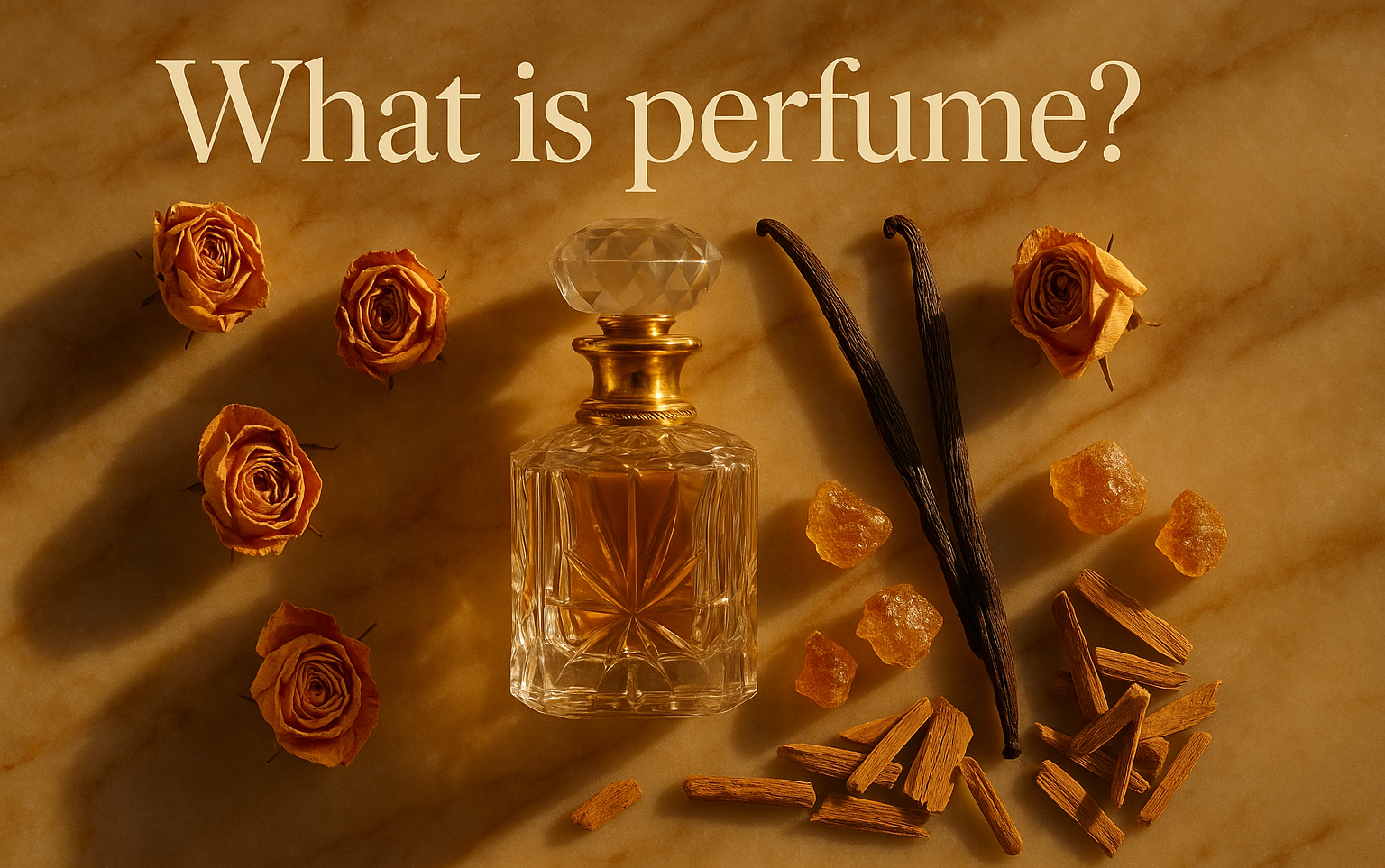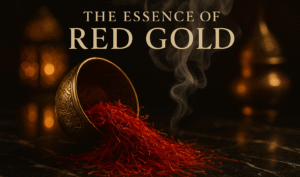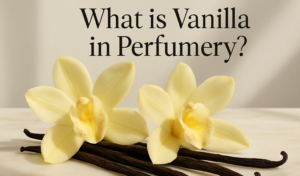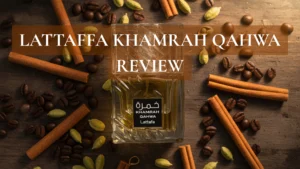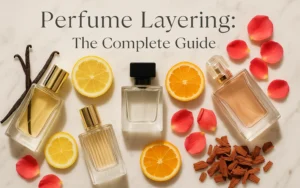Introduction to What Is perfume
What is perfume? Perfume is memory, mood, and identity captured in a bottle. It is both science and poetry, crafted from natural extracts and synthetic molecules to create something greater than the sum of its parts.
Perfume has fascinated humanity for thousands of years. Ancient Egyptians used resins and oils in both ritual and daily life, and the Ebers Papyrus (c. 1550 BCE) contains one of the earliest known perfume recipes. The Roman philosopher Pliny the Elder observed, “There is nothing which refreshes the spirit more than scents and sweet odours” (Naturalis Historia, Book XIII). This timeless bond between fragrance and emotion continues today.
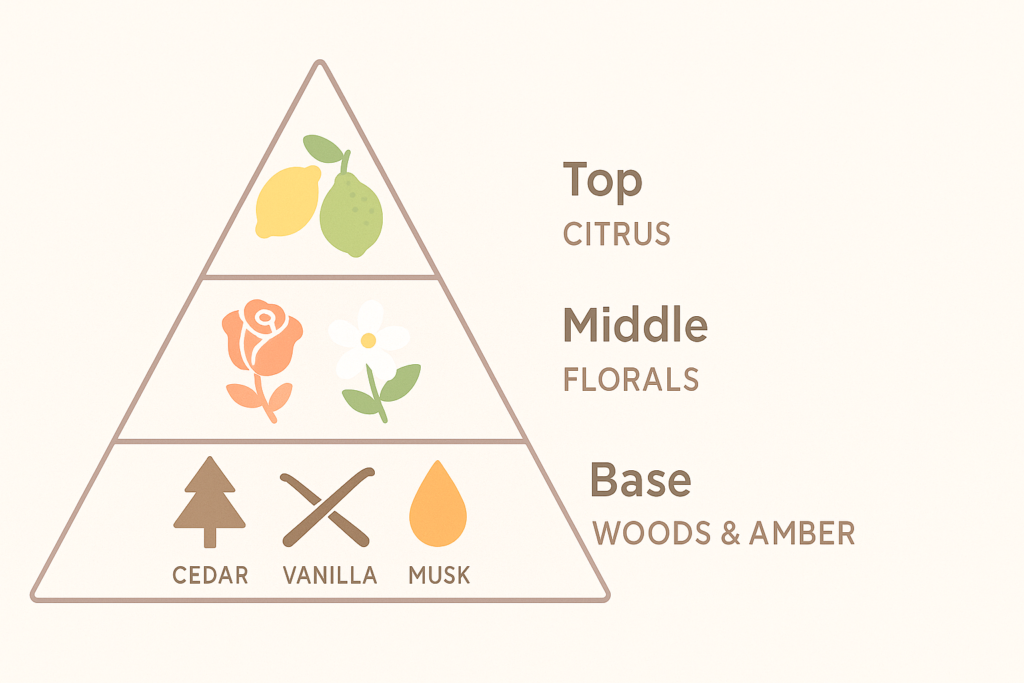
Modern science helps explain why. According to neuroscientist Dr. Rachel Herz, “Smell is the only sense that has a direct connection to the limbic system, the part of the brain that processes emotion and memory” (The Scent of Desire, 2007). This is why a single whiff of orange peel, vanilla, or leather can transport you instantly to another time or place.
About me
I am Rodrigo H, a fragrance consultant at a niche perfumery. Over the past five years I have helped hundreds of clients find scents that fit not only their skin chemistry but also their stories and personalities. In this guide, I will explain what perfume really is, how it is structured, why it behaves differently on each person, and how you can choose and wear fragrance with confidence. You can also explore How to Find Your Signature Scent if you want to match fragrance to personality.
Along the way, you will find:
- Practical tips to make perfume last longer.
- A breakdown of fragrance families and note structures.
- Advice on choosing scents for personality, season, and occasion.
- Expert guidance on layering fragrances without clashing.
Perfume is not just about smelling good. It is about feeling like the most authentic version of yourself.
Quick Summary on What Is Perfume
- Perfume is a blend of aromatic materials in alcohol or oil that evaporate in stages called top, heart, and base notes.
- Skin chemistry and climate strongly affect how a perfume smells and lasts. Always test on your own skin and wait for the drydown.
- Concentration, composition, and materials drive longevity and sillage. Dense bases such as woods, resins, musks, and amber last longer.
- Choose by personality, season, and occasion, not only by brand or gender label.
- Store cool and dark, moisturize skin before applying, and target pulse points to get better performance.
What Is Perfume, Really?
At its core, perfume is a carefully composed mixture of aromatic ingredients dissolved in a carrier such as alcohol or oil. These ingredients are chosen for their ability to evaporate into the air in a way that creates a scent trail. Yet perfume is more than chemistry. It is also an artistic composition, built with balance, contrast, and storytelling in mind.
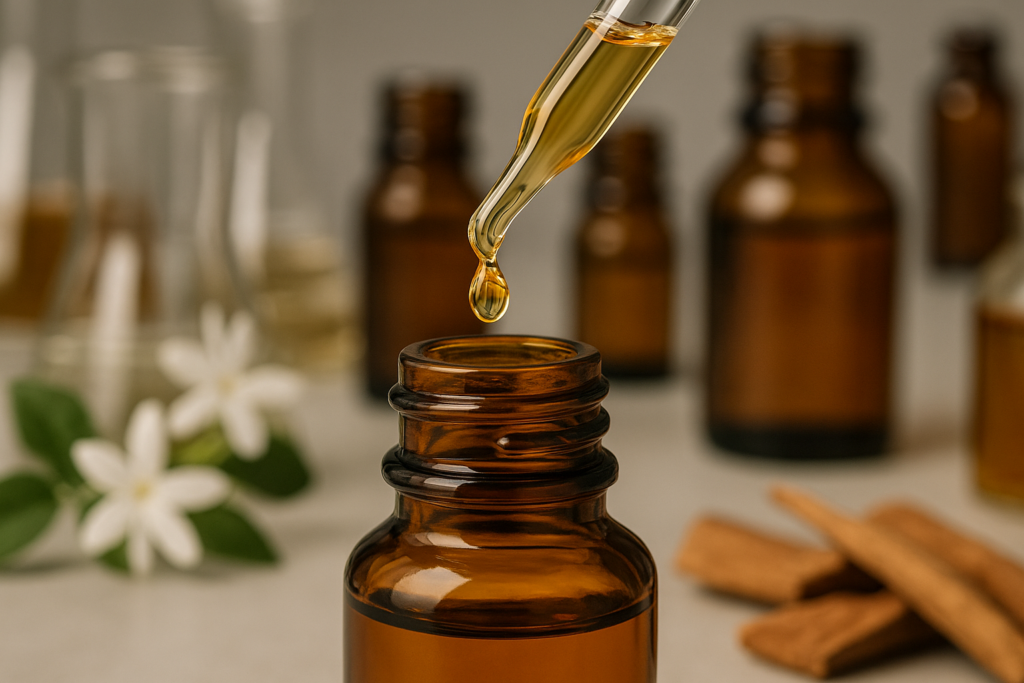
The French perfumer Jean-Claude Ellena once said in his book Perfume: The Alchemy of Scent, “Perfume is a story in odors, sometimes a poetry of memory.” This illustrates that perfume is not only about materials, but about the emotions and memories they awaken.
The Science of What Is Perfume
From a scientific perspective, perfume is made up of volatile molecules. When applied to the skin, body heat causes them to evaporate at different speeds. This is why a fragrance changes over time, moving from fresh citrus top notes to warm, lingering base notes. The International Fragrance Association (IFRA) defines perfume as “a mixture of fragrant essential oils, aroma compounds, and solvents used to give a pleasant scent to the human body, objects, or living spaces.”
Perfume materials fall into two main categories:
- Naturals: essential oils, absolutes, and resins obtained from plants, woods, flowers, and spices. These bring depth and nuance but vary depending on harvests and climate.
- Aroma molecules: synthetics designed in laboratories, such as Iso E Super or Ambroxan, which provide stability, clarity, and effects not found in nature.
Most modern perfumes use both. Naturals provide texture and richness, while synthetics give longevity, diffusion, and reproducibility.
The Art of What Is Perfume
Perfume is also a design language. Just as a composer arranges notes into a symphony, a perfumer arranges accords into a complete fragrance. These choices reflect cultural trends, market demands, and the perfumer’s personal style. The Osmothèque, the world’s perfume archive in Versailles, describes perfume as “an art that uses smell as its medium of expression.”
When you wear perfume, you are carrying both art and science on your skin. It is chemistry that becomes personal, transforming into something slightly different on every wearer. To better understand how styles are grouped, see What Are Fragrance Families.
The Three Building Blocks of What Is Perfume
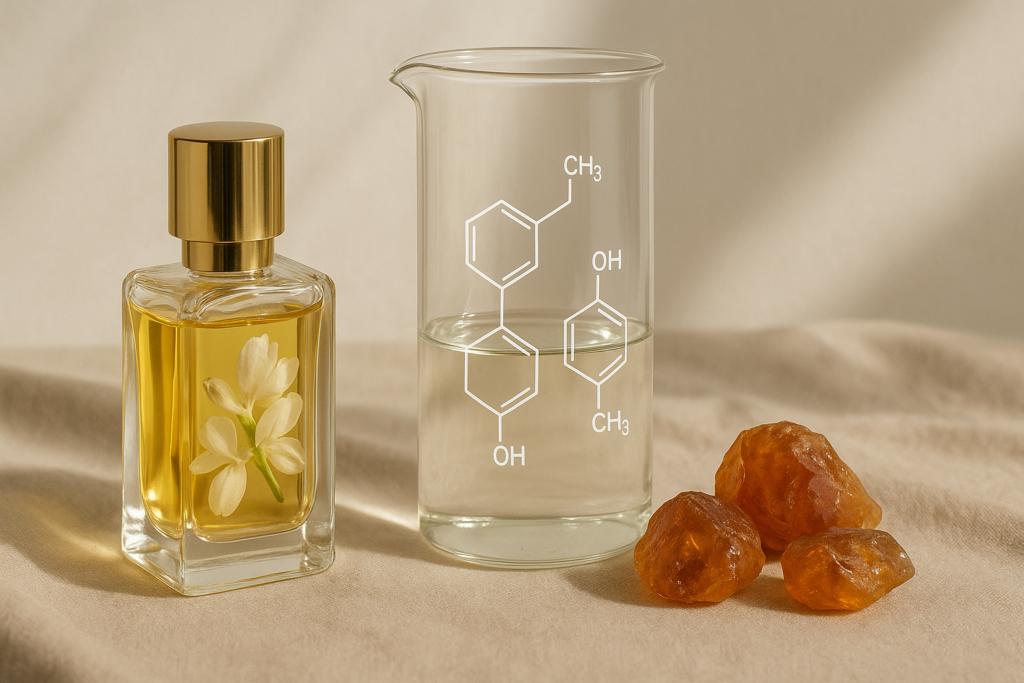
Every perfume, no matter how complex, is built on three fundamental elements: fragrance oils, a carrier, and fixatives. Understanding these is key to reading a perfume bottle like a pro.
Fragrance Oils
Fragrance oils are the heart of any perfume. They are the raw materials that give the fragrance its character.
- Naturals – Extracted from plants, flowers, fruits, spices, and resins. Examples include rose absolute, jasmine absolute, bergamot, patchouli, sandalwood, vanilla, and frankincense. Their beauty lies in nuance and richness, but their quality can vary by harvest, climate, and origin. The perfume capital of Grasse in France has cultivated roses and jasmine for centuries, supplying houses like Dior and Chanel with the finest extracts (Grasse Perfume Heritage).
- Aroma molecules – Synthetic compounds created in laboratories to replicate or enhance scents found in nature. Famous examples include Ambroxan (ambergris-like), Iso E Super (woody and transparent), and Hedione (airy jasmine note). These materials provide stability, clarity, and modern effects that naturals alone cannot achieve (Perfumer & Flavorist).
Carrier
The carrier allows perfume oils to diffuse. It determines how light or strong the scent feels.
- Alcohol – The most common carrier. It helps perfume spray easily and gives it lift and projection. Ethanol is the standard, purified to cosmetic grade.
- Oil – Used in attars and some niche perfumes. It creates a richer, closer-to-skin aura with less projection but longer intimacy. Attars from the Middle East and India are often oil-based, blending florals, oud, and spices (Osmothèque).
Fixatives
Fixatives are the anchors of a perfume. They slow down evaporation, extend longevity, and add depth.
- Natural fixatives – Resins like labdanum, benzoin, myrrh, and frankincense. These add warmth and body.
- Modern fixatives – Molecules such as musks and woody ambers that create long-lasting structure. Cashmeran, for instance, gives a soft woody-musky backdrop often used in niche perfumery.
The balance between oils, carrier, and fixatives is what makes each perfume unique. To see how these materials shape seasonal use, read How to Know Which Season a Fragrance Is Designed For. As the International Fragrance Association (IFRA) highlights, these formulas must also comply with strict safety standards to ensure that beauty and wearability go hand in hand.
What Is Perfume and How Is It Made: From Idea to Bottle
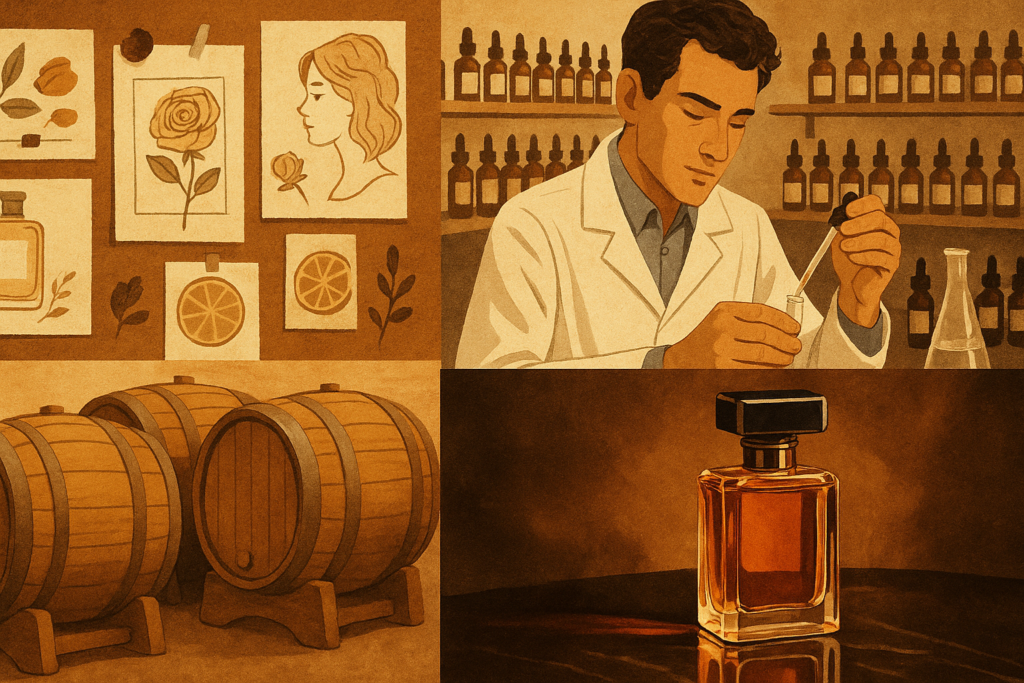
Behind every fragrance lies a long journey from concept to creation. Perfumery is both an art and a science, requiring months or even years of development before a bottle reaches the shelves.
1. The Brief and Story
A perfume usually begins with a creative brief. This document outlines the mood, target audience, and inspiration. For example, Dior might ask for “a fresh yet elegant summer fragrance for women in their twenties”. Some briefs are highly poetic, describing colors, places, or emotions rather than specific notes.
As perfumer Francis Kurkdjian explains, “A perfume is born from an idea, an olfactory sketch, and the desire to tell a story through scents” (LVMH Interview).
2. Accord Building
The perfumer then creates accords, which are small compositions that capture a single idea, like a suede leather accord or a smoky tea accord. These mini perfumes are tested, adjusted, and layered until they can be combined into a larger structure.
3. Structure: The Pyramid
Accords are arranged into a fragrance pyramid of top, heart, and base notes. This ensures the perfume evolves over time rather than staying flat. The pyramid is both technical (based on molecular volatility) and artistic (based on emotion and storytelling).
4. Stability and Safety
Once a draft formula is complete, it undergoes testing for stability, safety, and compliance. The International Fragrance Association (IFRA) sets global standards to limit allergens and ensure safe skin contact. Formulas may be adjusted if a material exceeds regulatory thresholds.
5. Maceration and Filtration
The concentrate is mixed into alcohol or oil and left to macerate for several weeks. This allows the different materials to “marry” and round out. Afterward, the blend is filtered to remove any particles or cloudiness, leaving a clear liquid.
6. Filling and Packaging
The perfume is then bottled, crimped, and boxed. At this stage, marketing and design teams collaborate on the visual identity: bottle shape, cap, color, and campaign. This step often costs more than the liquid itself.
Pro Tip: Reformulations Happen
Perfumes are sometimes reformulated due to ingredient restrictions, supply shortages, or cost adjustments. For example, oakmoss, a classic material in chypres, has been restricted under IFRA guidelines, leading brands to recreate its effect with synthetics. This is why a vintage bottle may smell slightly different from today’s version. Always test the current batch before restocking a favorite. If you want to maximize the performance of new bottles, check out How to Make Perfume Last Longer.
What Is Perfume Pyramid: How Notes Evolve
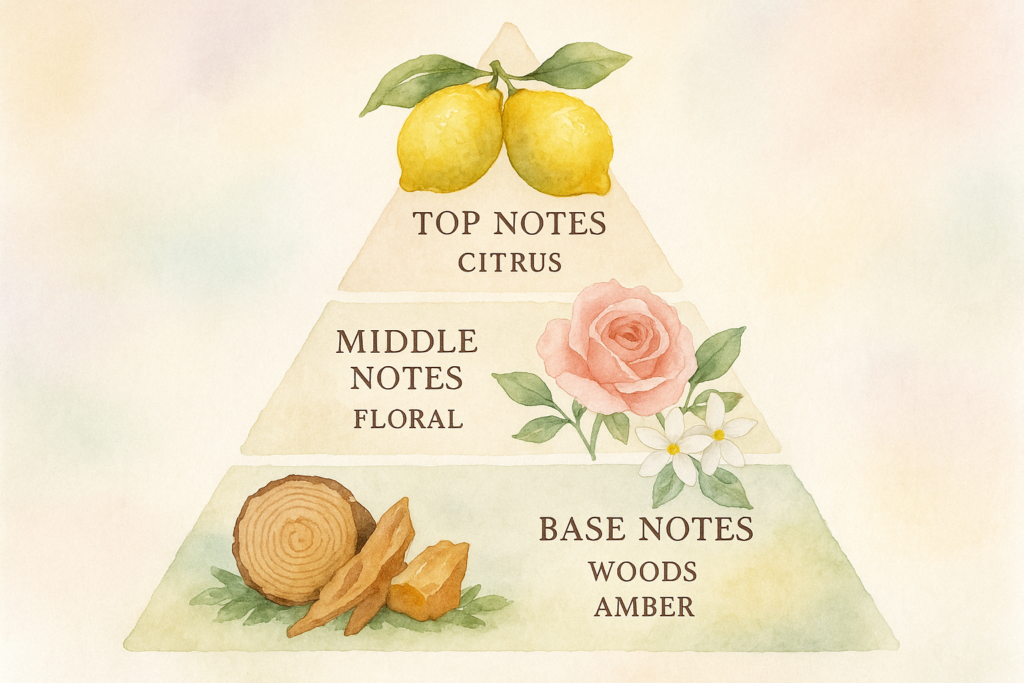
Perfume is designed to change over time. What you smell in the first few seconds is not the same as what lingers hours later. This transformation is described through the fragrance pyramid, a structure of top, heart, and base notes.
The French perfumer Edmond Roudnitska, creator of classics such as Dior Eau Sauvage, wrote, “A perfume must evolve like a living thing, revealing itself in stages to the one who wears it.” This is exactly what the pyramid explains.
Top Notes
These are the first impression of a fragrance. They are light, volatile molecules that evaporate quickly. Top notes usually last from 5 to 15 minutes.
- Common examples: citrus (bergamot, lemon, grapefruit), green notes, aromatic herbs, watery accords, and light florals like neroli.
- Function: to grab attention and set the mood.
Heart Notes
Often called the soul of the fragrance, heart notes appear after the top fades, usually 15 to 30 minutes into wear. They give the perfume its character and theme.
- Common examples: rose, jasmine, ylang-ylang, spices, tea, green notes, fruity accords, and aromatic herbs.
- Function: to bridge the freshness of the top with the depth of the base.
Base Notes
The memory of the fragrance. These notes last longest, often for many hours, and are built from heavier molecules. They form the foundation of the composition.
- Common examples: sandalwood, cedar, musk, amber, vanilla, tonka, patchouli, tobacco, leather, resins like benzoin or labdanum.
- Function: to give weight, warmth, and lasting presence.
Why It Matters
Understanding the pyramid helps explain why a perfume can feel disappointing at first but magical later, or why some fragrances disappear quickly. If you crave depth and all-day wear, look for strong bases with amber, oud, sandalwood, or musk.
Learn more about how these categories shape fragrance styles in What Are Fragrance Families.
What Is Perfume: Concentrations and Typical Longevity
Perfumes are sold in different concentrations, which describe how much aromatic oil is dissolved in alcohol or oil. This ratio influences not only strength, but also how long the fragrance lasts and how it projects.
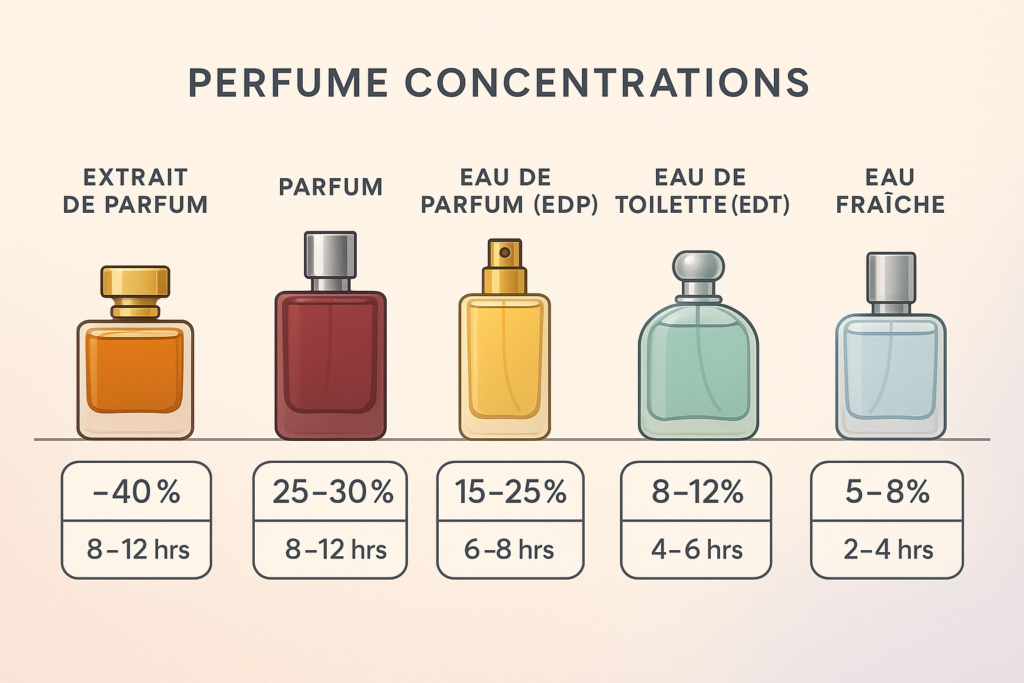
The Fragrance Foundation explains that “concentration is one of the key elements that determines the experience of a perfume, affecting intensity, longevity, and even how the notes unfold.”
Here is a guide to the most common concentrations:
| Type | Oil Concentration | Typical Longevity |
|---|---|---|
| Extrait de Parfum | 25–40% | 8–12 hours or more |
| Parfum / EDP Intense | 20–30% | 6–10 hours |
| Eau de Parfum (EDP) | 15–20% | 4–8 hours |
| Eau de Toilette (EDT) | 5–15% | 3–5 hours |
| Eau de Cologne (EDC) | 2–5% | 1–3 hours |
| Eau Fraîche | 1–3% | 1–2 hours |
What Influences Longevity Beyond Concentration?
- Skin type: Hydrated or oily skin retains fragrance better than dry skin.
- Climate: Heat makes scents bloom and project more, while cold weather keeps them closer to the skin.
- Composition: A citrus cologne may fade quickly, while a resinous amber or oud extrait can last over 12 hours.
- Application: Spraying on moisturized pulse points or clothing can extend performance.
Reformulations and Variations
Perfumes are sometimes reformulated because of ingredient regulations or sourcing issues. Oakmoss, once a key note in chypre fragrances, has been restricted under IFRA guidelines for safety reasons. This means a vintage bottle of Chanel No. 19 will not smell exactly like today’s release.
For this reason, always test the current version before repurchasing, especially if you have been loyal to a fragrance for many years.
Naturals Versus Aroma Molecules
Perfume is built from two main categories of materials: naturals and aroma molecules. Most modern fragrances use a combination of both, each offering unique qualities.
Naturals
Natural ingredients are obtained directly from plants, flowers, woods, fruits, or resins. Common methods include steam distillation, solvent extraction, and CO₂ extraction.
- Examples: rose absolute, jasmine absolute, bergamot oil, sandalwood, vanilla, frankincense, and patchouli.
- Strengths: rich nuance, depth, and a “living” character that feels organic.
- Limitations: natural materials can vary from harvest to harvest, and they are often more expensive. For example, it takes about 200,000 jasmine flowers to produce one ounce of jasmine absolute (Osmothèque).
Aroma Molecules
Aroma molecules, also called synthetics, are created in laboratories to replicate or extend natural scents. They became widespread in the late 19th century with discoveries like coumarin (tonka bean note) and vanillin (vanilla).
- Examples: Iso E Super (woody and transparent), Ambroxan (ambergris-like), Hedione (airy jasmine), Cashmeran (musky-woody).
- Strengths: consistent quality, stability, reproducibility, and the ability to create entirely new effects. For instance, Hedione gives an ethereal radiance that naturals alone cannot achieve (Perfumer & Flavorist).
- Limitations: some purists argue synthetics lack the “soul” of naturals, but in practice most masterpieces are hybrids.
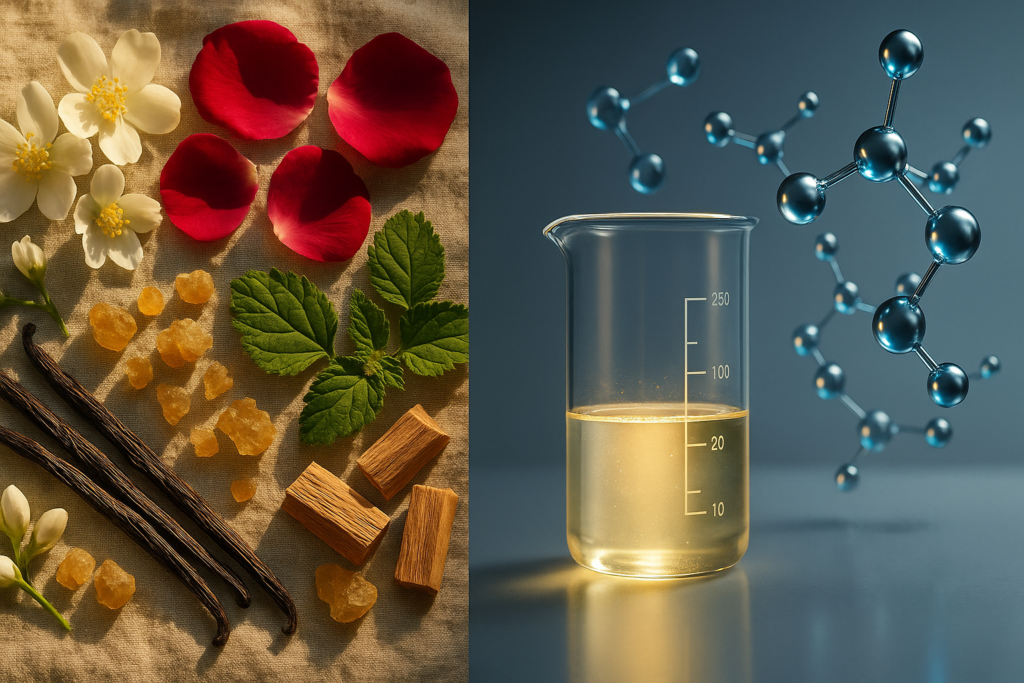
Balance and Modern Perfumery
The best perfumes are rarely all-natural or all-synthetic. Perfumers carefully balance both for the desired effect. Naturals bring texture and complexity, while aroma molecules provide lift, clarity, and diffusion.
Jean-Claude Ellena emphasized this balance in his book The Diary of a Nose, noting, “A perfume that contains only natural ingredients is often heavy. Synthetics bring transparency and air.”
Sustainability and Safety
Natural raw materials sometimes raise environmental and ethical concerns. Overharvesting of sandalwood and oud, for example, has endangered these species. Synthetic alternatives not only protect resources but also make perfume more affordable.
Safety is also critical. Some naturals contain allergens that can irritate skin. This is why the International Fragrance Association (IFRA) enforces strict regulations to protect consumers while allowing perfumers creative freedom.
Why Perfume Smells Different on Everyone
One of the most fascinating aspects of fragrance is how the same perfume can smell completely different from one person to another. This isn’t marketing hype — it’s a mix of biology, chemistry, and environment.
Skin Type and Hydration
Perfume molecules interact with the surface of your skin. Well-hydrated or oily skin retains fragrance better, while dry skin can cause it to fade quickly. Dermatologists note that skin’s lipid layer acts like a natural fixative, helping scent cling for longer. Applying an unscented moisturizer before spraying is one of the simplest hacks to improve longevity.
Temperature and Body Heat
Warm skin amplifies diffusion and projection. This is why perfumes often feel stronger in summer and lighter in winter. Cold temperatures keep molecules closer to the skin, muting their intensity. As perfumer Francis Kurkdjian explains, “The same perfume can seem powerful in July but discreet in January” (Vogue Interview).
pH, Diet, and Hormones
Subtle differences in body chemistry can change how notes develop. A slightly acidic skin pH might make citrus feel sharper, while a higher pH can soften florals. Even diet plays a role — spicy or sulfur-rich foods like garlic may influence how skin emits scent. Hormonal changes (puberty, pregnancy, menopause) also shift how perfume wears over time.
Environment and Climate
- Humidity: Heavy bases like amber, oud, and resins bloom in humid air.
- Dryness: Dry, cold climates favor lighter top notes such as citrus and tea.
- Airflow: Wind can disperse perfume quickly, while still indoor environments help it linger.
Testing Rule: Skin Over Paper
Blotters are useful for first impressions, but your skin tells the true story. Always test directly on your skin, ideally one scent per wrist or inner elbow, and wait at least two hours to experience the drydown. The Monell Chemical Senses Center confirms that scent perception is a personal experience shaped by both biology and environment.
👉 For practical tips on controlling these factors, see Why Perfumes Smell Different on You (and How to Fix It!).
How To Test Perfume Like A Consultant
- Shortlist: sniff on blotters to narrow choices to two or three.
- Skin test: one scent per wrist or inner elbow.
- Time: check again at 30 minutes, 90 minutes, and 3 hours.
- Reset: step outside for fresh air instead of coffee beans.
- Decision: only buy if you enjoy the drydown on your skin and in your real life setting.
At the counter: ask for a manufacturer sample or decant your favorite to wear for a full day before you commit.
Make Your Perfume Last Longer
- Moisturize first with an unscented lotion on pulse points.
- Target zones: wrists, neck, behind ears, inner elbows, and a light mist on hair or clothes if fabric allows.
- Do not rub wrists together. Let the spray settle.
- Storage: keep bottles away from heat and light. A drawer or cabinet is ideal.
Deep dive with practical hacks here: How to Make Perfume Last Longer.
What Is Perfume: Choosing the Right Scent for You
Finding the right perfume is less about gendered marketing labels and more about personality, lifestyle, and context. A fragrance should fit like a well-tailored outfit, enhancing your mood and reflecting who you are.
By Personality
Fragrance psychologist Dr. Joachim Mensching notes, “People choose fragrances that mirror their inner self or project the image they want others to perceive.”
- Fresh and clean: Citrus, aquatic, and green scents. Perfect if you like uplifting minimalism and an active lifestyle.
- Deep and mysterious: Woody, spicy, tobacco, and leather notes. Ideal if you prefer boldness, sensuality, or evening wear.
- Soft and romantic: Floral, fruity, powdery, or musky compositions. Great if you lean toward elegance and intimacy.
👉 Build a capsule of scents that matches your identity with How to Find Your Signature Scent.
By Season and Climate
Perfumes interact with weather, so a winter favorite may feel too heavy in summer.
- Summer and heat: Citrus, tea, green notes, and light florals that refresh without overwhelming.
- Spring and autumn: Aromatic fougères, light spices, and soft woods. Balanced for transitional weather.
- Winter and night: Amber, vanilla, oud, leather, tobacco, and balsams that provide warmth and depth.
👉 Discover how perfumers design with climate in mind in How to Know Which Season a Fragrance Is Designed For.
By Occasion
Perfume is a social accessory. Wearing the right scent can set the tone for the day.
- Office and study: Subtle musks, citrus woods, or tea accords. Clean and professional.
- Dates and evenings: Rose, spices, amber, or soft tobacco. Romantic and enveloping.
- Events and outdoors: Bolder projection with spicy ambers, incense, and woods. Confident and long-lasting.
By Longevity Preference
Not everyone wants a powerhouse fragrance that lingers all night. Longevity should match comfort and setting.
- Extrait or Parfum: For maximum staying power.
- Eau de Parfum (EDP): A versatile choice with balanced strength.
- Eau de Toilette (EDT) or Cologne: Perfect for breezy freshness, short outings, or hot climates.
What Is Perfume: Layering Fragrances Without Clashing
Fragrance layering is the art of combining multiple scents to create a personalized signature. When done well, it adds depth and individuality. When done poorly, it can feel overwhelming.
The Rule of Three
Keep layers to a maximum of three products. Too many notes competing at once can create confusion instead of harmony.
- Base: Start with a lotion or oil in a soft scent such as musk, vanilla, or sandalwood. This creates a foundation that helps other fragrances stick.
- Character: Apply your main perfume. This should be the star of your blend.
- Lift (optional): Add a light accent, such as a citrus cologne or tea spray, to give sparkle and freshness.
Practical Combinations
- Vanilla lotion + woody amber EDP + tea cologne → cozy, elegant, with a refreshing edge.
- Musk body oil + rose fragrance → clean intimacy with a romantic aura.
- Coconut lotion + white floral perfume → a vacation vibe that feels radiant in summer.
Expert Tip
As Roja Dove, British perfumer and fragrance historian, explains: “Layering allows you to create a scent that is yours alone, but balance is everything – one perfume must play first violin.”
When to Layer
- Perfect for evenings, when you want more presence.
- Useful when transitioning a lighter fragrance into colder months.
- A creative way to refresh older perfumes in your collection.
For a full step-by-step framework and advanced tips, read the dedicated Perfume Layering Guide.
Common Mistakes on What Is Perfume And How To Fix Them
- Overapplying indoors: aim for three to five targeted sprays.
- Testing too many at once: limit to two or three on skin.
- Judging on the first five minutes: always wait for the heart and base.
- Storing on a sunny shelf: move bottles to a cool, dark space.
- Ignoring climate: adjust your choices by temperature and humidity.
What Is Perfume and Mini Ingredient Spotlights
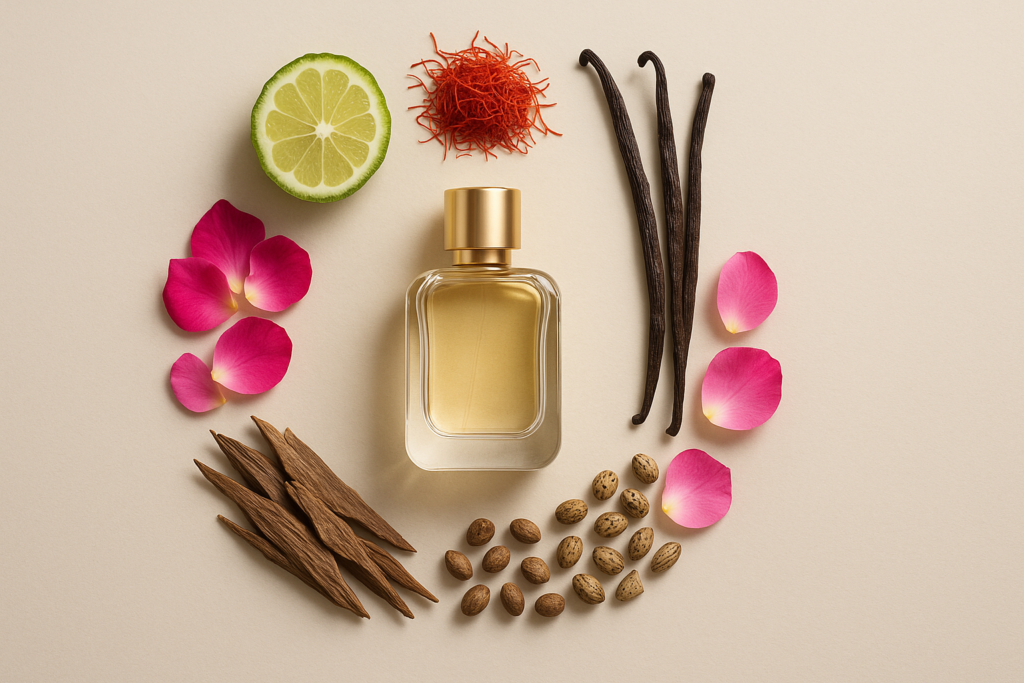
Learning to recognize key perfume ingredients helps you read a fragrance like a critic. Here are some of the most important building blocks you will encounter:
Citrus Family
- Profile: Bright, crisp, refreshing, but short-lived.
- Examples: Bergamot, lemon, orange, grapefruit, petitgrain.
- Use: Excellent for summer, office wear, or post-gym freshness.
Florals
- Profile: The backbone of perfumery, from airy blossoms to opulent bouquets.
- Examples: Orange blossom, rose, jasmine, tuberose, iris.
- Use: Versatile, spanning from romantic elegance to bold sensuality.
👉 Dive deeper into one of the most refined floral ingredients in What Is Iris in Perfumery?.
Woods
- Profile: Grounding, elegant, often genderless.
- Examples: Sandalwood, cedarwood, guaiacwood, vetiver.
- Use: Adds sophistication and depth. Key in both designer classics and niche icons.
👉 Learn more about deep woody materials in What Is Oud in Perfumery? The Complete Guide.
Amber and Resins
- Profile: Warm, enveloping, often sweet or balsamic.
- Examples: Labdanum, benzoin, vanilla, tonka bean.
- Use: Excellent for winter or evening fragrances, creating cozy depth.
Osmothèque archives describe amber as “a fantasy accord born in the 19th century, now a pillar of modern perfumery.”
Spices
- Profile: Add lift, heat, or sensuality depending on the blend.
- Examples: Cardamom, cinnamon, pepper, saffron.
- Use: Fantastic for date nights, cold weather, or gourmand twists.
👉 For an in-depth look at one of the most luxurious spices, see What Is Saffron in Perfumery?.
Musks
- Profile: Soft, skin-like, clean or animalic depending on type.
- Examples: White musks (modern, clean), nitro musks (historic), natural deer musk (historic and now banned).
- Use: The backbone of many fragrances, often used as a base for layering and longevity.
👉 Explore the full story in What Is Musk in Perfumery?.
Modern Icons (Bonus)
Beyond naturals, some modern synthetics deserve mention:
- Ambroxan: A woody amber molecule with mineral, skin-like warmth.
- Iso E Super: A transparent, velvety-woody note, famous for its “you but better” aura.
- Hedione: An airy jasmine molecule, said to activate brain receptors linked to attraction.
👉 Curious about the role of synthetics? Revisit Naturals Versus Aroma Molecules.
What Is Perfume, Budget, Designer, Niche: How to Shop Smart
Perfume shopping does not have to be intimidating. Whether you are just starting out or already building a collection, understanding the three main market levels will help you make smarter choices.
Budget and Entry Level
Affordable perfumes can still deliver quality and charm.
- Where to look: celebrity fragrances, Zara, department store exclusives, or discovery sets.
- Best strategy: start small with travel sizes or sets before committing to a full bottle.
- 👉 See our guide to 10 Best Perfumes Under $50 That Smell Like Luxury for affordable gems that punch above their price.
- 👉 If you are exploring celebrity scents, read the Ariana Grande Fragrance Guide or the Billie Eilish Perfume Guide.
Designer Fragrances
Designer houses like Dior, Chanel, Yves Saint Laurent, and Prada offer perfumes with broad appeal.
- Pros: wide availability, often versatile, reliable quality.
- Cons: frequent flankers and occasional reformulations, so always test the current batch.
- 👉 Explore our Prada Luna Rossa Buying Guide and Valentino Perfume Guide for Men for examples of how to navigate designer lines.
- 👉 For timeless classics, see Best Spicy Fragrances for Men or Best Vanilla Perfumes for Women.
Niche and Artisan Perfumes
Niche perfumery is where artistry shines. These perfumes are created for distinction rather than mass appeal.
- Pros: bolder concepts, richer naturals, and unique materials.
- Cons: higher prices and more polarizing compositions.
- Best approach: sample through discovery kits and travel sprays before committing to a full bottle.
- 👉 Learn the essentials in What Are Niche Perfumes?.
- 👉 Discover treasures in Best Spring Niche Perfumes: Hidden Gems.
- 👉 Read reviews of niche icons like Xerjoff Erba Pura or Matière Première Parisian Musc.
Sampling Plan
Roja Dove, perfumer and historian, advises: “Never judge a perfume by one quick sniff, live with it for a day.” A practical sampling strategy will save money and frustration:
- Pick a theme for each store visit, such as “fresh woods” or “amber vanillas.”
- Shortlist on blotters, then test your favorites on skin.
- Wear your top candidate for a full day before buying.
👉 For more inspiration, check out our reviews of Givenchy Gentleman EDP Boisée and the Tom Ford F Fabulous.
Care, Storage, and Shelf Life of What Is Perfume
A perfume is delicate chemistry in a bottle. How you store it can make the difference between enjoying it for years or watching it degrade within months.
The Enemies of Perfume
According to the Fragrance Foundation, the main threats to perfume are light, heat, and oxygen. These elements break down aromatic molecules, causing discoloration, sour notes, or loss of projection.
- Light: UV rays accelerate oxidation. Even transparent bottles are vulnerable.
- Heat: Warm temperatures destabilize the blend. Avoid windowsills, cars, or bathrooms.
- Oxygen: Each spray introduces air. Over time, this can flatten the scent.
Best Practices for Storage
- Keep bottles in a cool, dark place such as a drawer, cabinet, or closed shelf.
- Maintain a stable temperature around 15–20°C (59–68°F).
- Store upright to prevent leakage and air pockets.
- Avoid frequent shaking, which can disrupt the balance of oils and alcohol.
Shelf Life and Expiry
Most perfumes last 3 to 5 years if stored properly. Some amber-heavy or resinous perfumes can remain beautiful for over a decade, while citrus colognes fade faster.
Signs of expiration include:
- Noticeable color change (darkening or cloudiness).
- A sour, vinegar-like top note.
- Weak projection or muted heart and base notes.
Dermatologists recommend avoiding expired perfumes on skin, though you can repurpose them to scent stationery, scarves, or even room sprays.
Travel and Decants
Use atomizers for portability, but refill sparingly to reduce air exposure. Keep travel sprays in a bag or pouch to shield them from light.
Frequently Asked Questions About What Is Perfume
Store perfume in a cool, dark, and dry place. Avoid heat, humidity, and direct sunlight to preserve its quality.
Perfume fades faster on dry skin or in hot weather. Apply to moisturized pulse points and choose stronger concentrations like Eau de Parfum or Extrait.
Most perfumes work best with three to five sprays. Use fewer indoors and a little more outdoors.
No. Perfumes are genderless. Labels like “for men” or “for women” are marketing categories.
Paper blotters are good for first impressions, but skin testing is essential to see how a perfume develops with your body chemistry.
Yes. Most perfumes last three to five years. Signs of expiration include color change, sour smell, or weak projection.
Conclusion on What Is Perfume
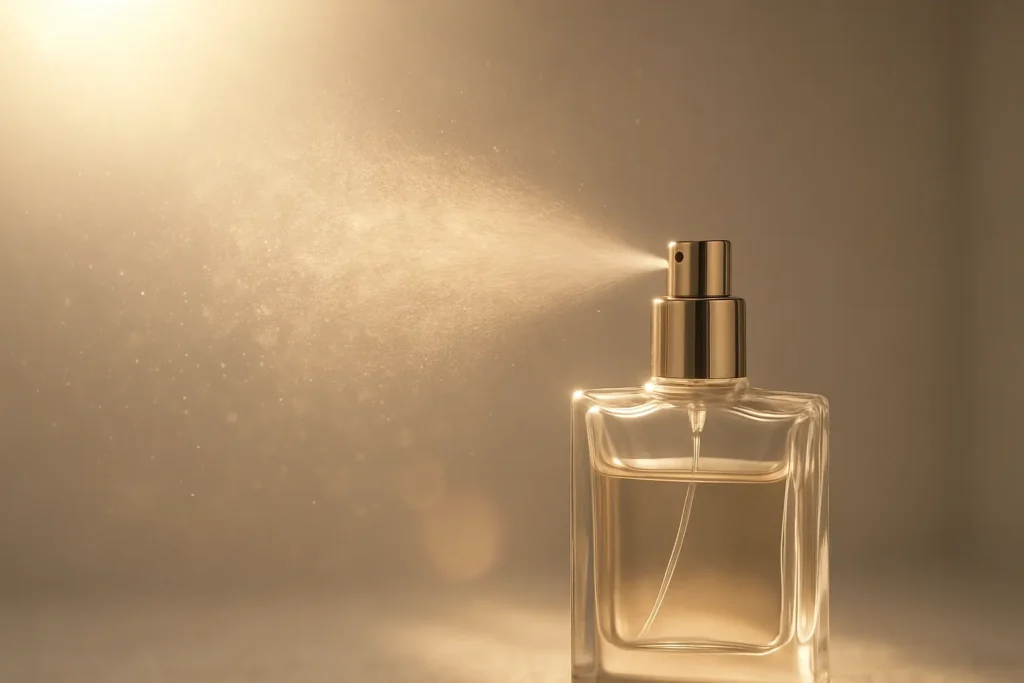
Perfume is more than a pleasant scent. It is memory, identity, and artistry woven into liquid form. From ancient rituals in Egypt to modern innovations in niche perfumery, fragrance continues to shape how we express ourselves and connect with others.
Understanding how perfumes are built, how they evolve on skin, and how to choose the right one gives you the confidence to navigate the fragrance world like a true connoisseur. Whether you prefer citrus freshness, floral romance, or resinous depth, there is always a scent that can feel uniquely yours.
Perfume is not just about smelling good. It is about telling your story, one spray at a time.
Keep Exploring the World of Fragrance
Perfume is just the beginning of the journey. If you’d like to dive deeper, here are some guides and reviews that will help you expand your fragrance knowledge and discover your next signature scent:
- 🌿 What is Oud in Perfumery? – Explore one of the most luxurious and mysterious ingredients in modern perfumery.
- ✨ What is Ambroxan in Perfumery? – Learn about the modern aroma-chemical behind many fresh and long-lasting scents.
- 💨 What is Sillage in Perfumery? – Discover why some perfumes leave a trail and how it changes with skin, weather, and fragrance families.
- 🍁 Best Fall Perfumes for Men – Warm, spicy, and elegant fragrances to transition into the colder months.
- 🍂 Best Fall Perfumes for Women – Cozy, sensual, and chic scents perfect for autumn outfits.
- 💎 Xerjoff Erba Pura Review – A fruity, musky niche fragrance that has become a modern classic.
- 🔥 Xerjoff Naxos Review – A sweet, spicy tobacco-honey masterpiece inspired by the spirit of Sicily.
Keep browsing Scent Chronicles to discover fragrance reviews, guides, and tips that make it easier to choose the perfume that feels like you.
I may earn a commission if you buy through links on this page, at no extra cost to you. As an Amazon Associate, I earn from qualifying purchases. I only recommend fragrances I’ve tested or genuinely believe in.

About Rodrigo Hernández
Fragrance consultant at Liquo (Santiago, Chile). I test designer and niche releases weekly, keep personal wear logs, and cross-check notes and performance in different climates. Opinions are my own; no brand pays for favorable coverage.
Contact: contact@scentchronicles.com

